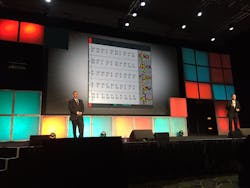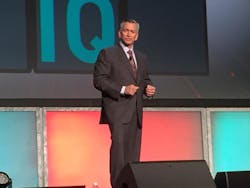The pace of technological change is accelerating in trucking
NASHVILLE. The demand for faster, cheaper and more accurate delivery of goods is only increasing, according to two top transportation technology executives speaking here at the 2017 PeopleNet and TMW Systems in.sight user conference and exposition.
“It’s no longer enough to think about business linearly; we need to think about it exponentially and that’s especially true for transportation,” noted David Wangler president of TMW Systems and also recently-appointed president of the newly formed Trimble Transportation Enterprise division, which comprises TMW Systems and ALK Technologies.
“Transportation is the engine that drives the on-demand economy, which is marrying unlimited selection of goods to immediate availability delivered to the point of consumption, not purchase,” he stressed.
That in turn is making so-called “final mile delivery” the “ultimate battlefield,” in his words, for freight transportation providers.
Indeed, Wangler said final mile delivery can represent from 42% to 50% of total transportation cost, which is why there is an “increasing premium” on being able to deliver real-time freight visibility.
“Regardless of product category, the on-demand economy is revolutionizing the movement of goods from supplier to end user,” he noted in his remarks.
“The digital mobility first offered in early devices has today become the catalyst for millions of business-critical actions occurring every second,” Wangler stressed. “The winners in this revolution will be those who maximize their ability to leverage information in real-time for increased efficiency and agility.”
Brian McLaughlin, president of PeopleNet and now also president of Trimble Transportation Mobility – a newly-formed division will include several business units, including PeopleNet, Innovative Software Engineering (ISE), Trimble Oil & Gas Services, Trimble Final Mile Mobility, Trimble Mobility Solutions India (TMSI) and several others – stressed that technology is going to play “a key role” in shaping transportation’s role in the “on-demand economy.”
By extension, that in turn “will shape our culture and the way we live,” he emphasized.
McLaughlin targeted the importance of achieving a connected supply chain to address the competitive challenges associated with an on-demand economy—a supply chain that will rely in part on connected trucks, connected drivers, connected freight and above all “connected intelligence” for linking them all together into what he called “Internet of Transportation Things.”
“Establishing a connected supply chain will serve to enable safer drivers and fleets, more environmentally friendly operations and vastly improved efficiency,” McLaughlin said.
“Mobility has exploded; over 90% of truck drivers today have a smart phone,” he pointed out. “Mobile apps [on those phones] will allow for greater freight visibility, providing ‘connected delivery’ especially for final mile shipments.”
TMW’s Wangler emphasized that today’s mobile devices and related technologies serve as “the driving force” behind the rapid rise of business-to-business and business-to-consumer e-commerce activity and the resultant “omni-channel” business model.
“As online sales continue to grow at 15% annually and consumer expectations increase, the transportation industry is becoming increasingly reliant on the capture, analysis and exchange of data to deliver products as quickly and efficiently as possible,” he stressed.
As a result of all of that, Wangler explained that freight transportation businesses are faced with an increasingly complex global supply chain characterized by evolving distribution models, shrinking delivery windows and reduced margin for error.
“These changes have spurred increased diversification among for-hire carriers, brokers, 3PLs [third party logistics firms] and private fleets, and heightened the need for dramatically improved asset maintenance practices,” he said. “In doing so, transportation businesses are turning to technologies that allow near real-time decision making through the use of predictive analytics and deep visibility into each step of the order and fulfillment process.”
About the Author
Sean Kilcarr
Editor in Chief
Sean Kilcarr is a former longtime FleetOwner senior editor who wrote for the publication from 2000 to 2018. He served as editor-in-chief from 2017 to 2018.


